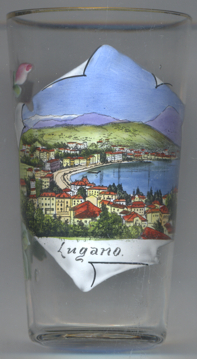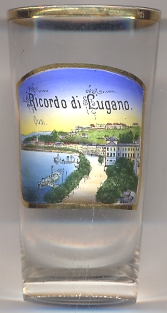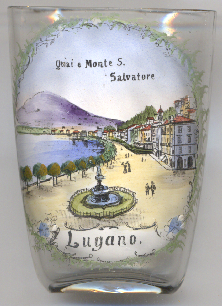

|
| SCHWEIZ / SUISSE / SVIZZERA / SVIZRA | SWITZERLAND |
| Tessin / Tessin / Ticino / Tessin |
de: Lugano, Lauis
| fr, it, rm: Lugano
| |
Lugano is situated at an elevation of 273 m on Lake Lugano in the south of the Italian-speaking canton of Ticino, which borders Italy. The population of the city proper was 55,151 as of December 2011, and the population of the urban agglomeration was over 145,000. It is the 9th-largest city of Switzerland by population, the largest city in Ticino, and the largest Italian-speaking city outside of Italy.

 The first written mention of a settlement at Lugano can be found in documents, which are of disputed authenticity, with which the Longobard king, Liutprand,
ceded various assets located in Lugano to the Church of Saint Carpophorus in Como in 724. Other documents, dating from 804 and 844 refer to Lake Lugano as
Laco Luanasco, in 1874 it was mentioned as Luano, and from 1189 as Lugano. German-language variants of the name (now no longer in use)
were Lowens, Lauis, Lauwis. The etymology of the name is uncertain, suggestions include derivation from lucus ('grove') and from a vulgar Latin
lakvannus ('lake-dweller'). An act of 984 indicates Lugano as a market town. It was the object of continuous disputes between the Dukes of Como and
Milan until it became a Swiss dominion in 1513. Swiss control lasted until 1798 when the Old Swiss Confederation was conquered by
Napoleonic France and was replaced by the Helvetic Republic. Under the Helvetic Republic, Lugano became the center of the canton of Lugano. With the Act of Mediation (1803) the canton
of Lugano merged with Bellinzona creating the canton of Ticino, which endures to the present day. The cantonal constitution of 1814 set Lugano, Bellinzona and
Locarno as capitals of the Canton. They each served as the capital in a six-year rotation. Lugano was the capital in 1827–33, 1845–51 and 1863–69.
From the mid-19th century to 1970 the city recorded constant population growth, especially between 1880 and 1910, when the population more than doubled.
In 2004 the municipalities of Breganzona, Cureggia, Davesco-Soragno, Gandria, Pambio-Noranco, Pazzallo, Pregassona and Viganello were incorporated into the city.
In 2008, they were followed by Barbengo, Carabbia and Villa Luganese.
The first written mention of a settlement at Lugano can be found in documents, which are of disputed authenticity, with which the Longobard king, Liutprand,
ceded various assets located in Lugano to the Church of Saint Carpophorus in Como in 724. Other documents, dating from 804 and 844 refer to Lake Lugano as
Laco Luanasco, in 1874 it was mentioned as Luano, and from 1189 as Lugano. German-language variants of the name (now no longer in use)
were Lowens, Lauis, Lauwis. The etymology of the name is uncertain, suggestions include derivation from lucus ('grove') and from a vulgar Latin
lakvannus ('lake-dweller'). An act of 984 indicates Lugano as a market town. It was the object of continuous disputes between the Dukes of Como and
Milan until it became a Swiss dominion in 1513. Swiss control lasted until 1798 when the Old Swiss Confederation was conquered by
Napoleonic France and was replaced by the Helvetic Republic. Under the Helvetic Republic, Lugano became the center of the canton of Lugano. With the Act of Mediation (1803) the canton
of Lugano merged with Bellinzona creating the canton of Ticino, which endures to the present day. The cantonal constitution of 1814 set Lugano, Bellinzona and
Locarno as capitals of the Canton. They each served as the capital in a six-year rotation. Lugano was the capital in 1827–33, 1845–51 and 1863–69.
From the mid-19th century to 1970 the city recorded constant population growth, especially between 1880 and 1910, when the population more than doubled.
In 2004 the municipalities of Breganzona, Cureggia, Davesco-Soragno, Gandria, Pambio-Noranco, Pazzallo, Pregassona and Viganello were incorporated into the city.
In 2008, they were followed by Barbengo, Carabbia and Villa Luganese.

The  Fontana Antonio Bossi [near left, no. 4842: foreground]
was built in memory of the opening of the municipal aqueduct (1895) thanks to a legacy from industrialist, lawyer
and politician Antonio Bossi (1829–1893). The fountain was designed by Otto Maraini, the bronze parts were
made by Luigi Vassalli. The lower part consists of a base and four basins surmounted by masks and shells; the
upper part consists of a plinth with dolphins supporting a circular basin decorated with lion heads. The fountain
has a width of 7.5 metres and a height of 6 metres.
Fontana Antonio Bossi [near left, no. 4842: foreground]
was built in memory of the opening of the municipal aqueduct (1895) thanks to a legacy from industrialist, lawyer
and politician Antonio Bossi (1829–1893). The fountain was designed by Otto Maraini, the bronze parts were
made by Luigi Vassalli. The lower part consists of a base and four basins surmounted by masks and shells; the
upper part consists of a plinth with dolphins supporting a circular basin decorated with lion heads. The fountain
has a width of 7.5 metres and a height of 6 metres.
The picture on glass no. 4842 is labeled Quai e Monte S. Salvatore. The quay today is named
in Italian Lungolago or Riva, but on this glass, and almost invariably on postcards of the time,
is identified by the French expression, quai. The stretch of the quay depicted here is
 Riva
Riva
 Monte San Salvatore (912 m) [background] is a mountain in the
Lepontine Alps above Lake Lugano and just south of the city centre of Lugano. A funicular links the city with the
summit of the mountain.
Monte San Salvatore (912 m) [background] is a mountain in the
Lepontine Alps above Lake Lugano and just south of the city centre of Lugano. A funicular links the city with the
summit of the mountain.
[https://de.wikipedia.org/wiki/Lugano, http://en.wikipedia.org/wiki/Lugano;
https://patrimonio.luganocultura.ch/oggetti/107335-fontana-antonio-bossi; https://de.wikipedia.org/wiki/Antonio_Bossi;
https://en.wikipedia.org/wiki/Vincenzo_Vela;
https://en.wikipedia.org/wiki/Monte_San_Salvatore]
![[scale]](lineal.jpg)